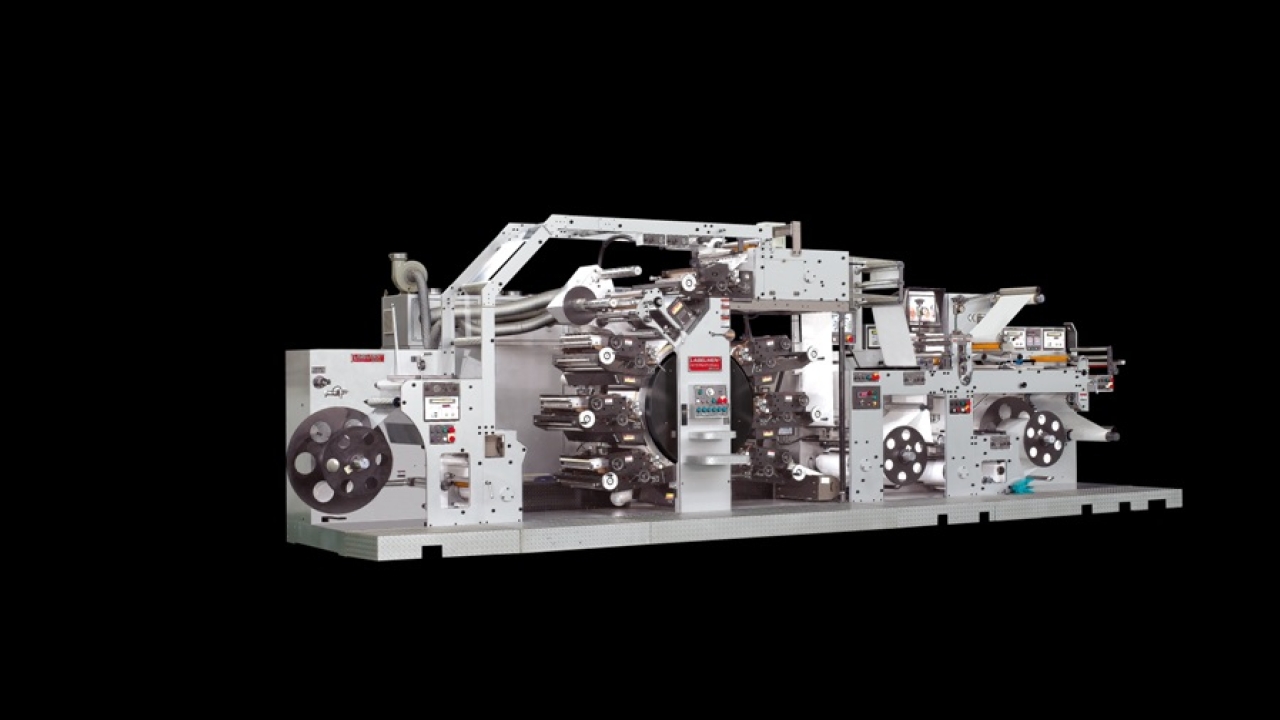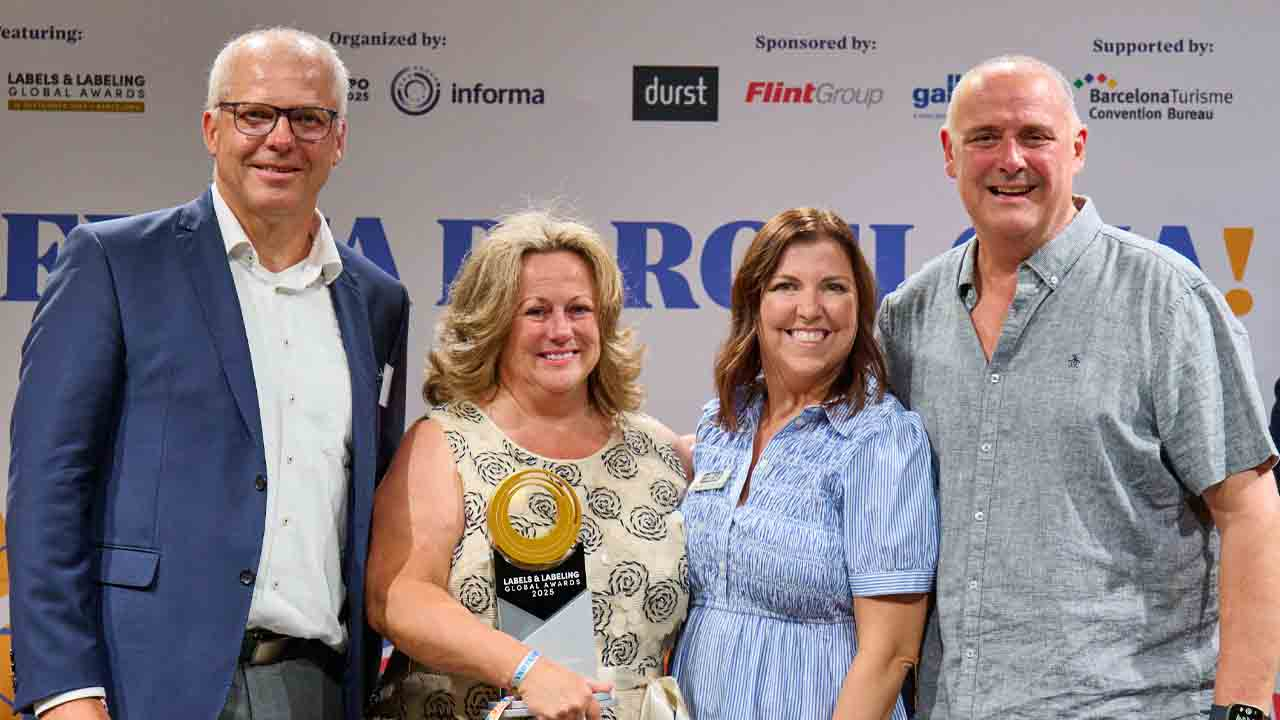Labelmen pushes in-mold boundaries

This is the culmination of 15 years of research into new ways of tackling the problem of single-pass production of in-mold labels.
‘We were originally co-operating with Avery Dennison at its Kunshan training center to make a total solution available,’ says Alan Lo, Labelmen CEO. ‘Later, we cooperated with various material suppliers.
‘Our aim was then to partner with the whole supply chain, from material supplier to manufacturer of in-mold labeling machinery – and to offer blow mold as well as injection mold solutions.’
For IML applications like drinking cups, the key issue is avoiding ink migration, says Lo. ‘There are dangers even where you use low migration inks, because consumers touch a part of the pack then put their fingers in their mouths. Then you have a big issue.’
Lo says this is a particular problem with the new generation of containers where consumers peel open the pack and drink from it.
‘The same problem with ink migration can occur when your mouth touches the neck label on a glass bottle you are drinking from.’
Labelmen’s answer is in-line lamination which encapsulates the inks so there is no possibility of direct contact between ink and food. This laminate-based IML technology is also microwave-safe: the laminate is guaranteed not to peel away in a microwave oven.
Labelmen uses a standard PP laminate so the same supply chain can be used in any country. The laminate has a total thickness of 80 microns and is fully recyclable with the container.
Single pass IML
Labelmen’s IML machine is the PW-460-R6C 1-type, a 6-color full rotary letterpress built around the company’s established CI drum design with additional flexo varnish unit. The press is specifically designed for roll-to-sheet operation and to minimize electro-static build-up, with dedicated tension control systems for handling unsupported in-mold films. It includes an in-line rotary die-cutter and wet lamination device and optional cold foil station. The 460mm-wide PW-460-R6C is designed to be compatible with Taiwan’s strict food grade packaging standards.
The in-mold labels are manufactured in a single pass, from in-line printing to through die-cutting and delivery. The Central Impression Drum (CID) press design combined with Labelmen’s cool curing UV system helps the IML materials pass through the press without distortion.
Jim Tien, sales director at Labelmen, says that converters will have the advantage of being part of a complete supply chain. They will use Labelmen-certified materials and sell to selected molding companies. In some cases, the customer for the press is the injection molding company itself, as the bigger ones have their own in-house printing divisions.
‘It is only the end section of the press that changes,’ says Lo. ‘So the same press can also produce shrink sleeves, laminate tubes and flexible packaging as well as IML, just with a change at the converting end – cut-through for IML and slitting for shrink sleeves and laminate tubes.’ The typical laminate/IML/flexible packaging press is 460mm wide, while 260mm-wide is more common for PS labels.
Alan Lo believes that IML is set for take-off in Greater China now as it has the official support of the Chinese government. ‘The government has much power. If it wants to develop a market they develop it quickly.’
At the same time, Lo sees other signs of a growth of IML. For example Coca-Cola is developing a PP can with integrated IML label – ‘This could be part of a wider future trend.’
One converter using Labelmen presses for in-mold label production is Wan Long Printing Co, a 25-year old label converter located in Nantou, Taiwan. The company prints flexo on both transparent and opaque IML films, both injection and blow mold.
Its target markets include cosmetics, detergents, medical products and engine oils. Wan Long also prints a wide range of pressure-sensitive label products including resealable labels for the markets of food, wine and beverage and cosmetics labels.
Beyond letterpress – offset, flexo and screen
Labelmen has followed press market trends as western markets migrated from letterpress to flexo and offset, and now offers a full range of processes.
‘We can produce either flexo or letterpress CID presses, depending on the market,’ said Alan Lo. ‘It is generally letterpress for Asia and flexo for Europe. We will keep producing CID letterpress as long as there is demand in our clients, especially for films.’ At present, Labelmen remains a major player in the letterpress market.
Silkscreen presses remain a strong part of Labelmen’s offering. The company manufactures its own silkscreen presses, and also sells SilkStar series machines.
‘Silkscreen is continually growing,’ says Lo. ‘We sell screen finishing machines for digital labels, for printed electronics like RFID or flexible PCBs, where we print panels on thin film. Our machines also screen-print blood sugar testing kits using 3M materials which are die-cut and laminated on highly automated lines.’
In the automotive market, car dash units are manufactured by reinserting up to twelve times into screen print machines before being punched and die-cut. Most recently, Labelmen entered the offset market with its innovative RS-350PS intermittent press.
‘We started developing the offset press in response to customer requests for higher resolution print technologies,’ notes Lo. ‘Also because offset is a major global technology and many pre-press technologies are available for it. The link between offset and letterpress technologies is close.’
The RS-350PS press uses a ‘short’ or ‘keyless’ Ani-Print inking system, allowing Labelmen to make use of its flexo expertise combined with the advantages of cheaper offset plates and global offset standards. The Ani-Print inking system consists of ceramic anilox rollers and a double doctor blade unit, combined with a dampening circulation system for wet offset printing.
Lo says, ‘Short inking allows us to achieve a “digital” target with no ghosting.’
The press includes what Labelmen calls ‘CNC One-touch makeready’, remote monitoring and optional Martin MBSC auto butt splicer and STR automatic turret rewinder, and it can work with Labelmen’s own non-stop waste removal system. This machine uses specially designed cutting blades and a conveyor to remove adhesive waste smoothly.
‘Non-stop has many advantages for our offset presses because it means no parameter changes between rolls,’ says Lo. ‘Waste is a big issue for shorter runs.’
Labelmen’s intermittent offset print sections are combined with full rotary converting. ‘You can’t get the same accuracy for cold foil and lamination with intermittent machine operation,’ says Lo.
The RS-350PS press is fully modular in design, and can incorporate one or two multi-functional flexo stations. This allows, for example, first-down printing of opaque white, or a unit configured for cold foil and adhesive-side printing. The RS-350PS press is specified with a low temperature UV system.
Future developments
Labelmen has no current plans to develop a digital press – although it is developing finishing machines for digital presses. But the company does have an interest in digital technology. In fact, Labelmen has a separate R&D department researching a 3D virtual reality system (VR) system which can be incorporated into labels or flexible packaging. Labelmen is currently applying for a patent for this technology.
In conclusion, Labelmen is a company which has taken a long journey from its early basic letterpress machines to advanced engineering and unique R&D, concentrating on niche markets such as in-mold, anilox-inking wet offset and now an advanced 3D VR system for printing.
It will be interesting to see how this rebranding helps the company retain its global foothold in the labels and film packaging business.
Stay up to date
Subscribe to the free Label News newsletter and receive the latest content every week. We'll never share your email address.


